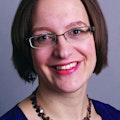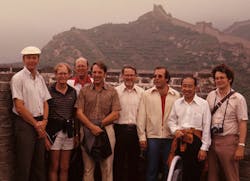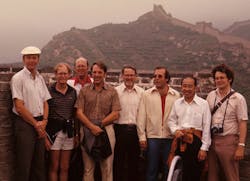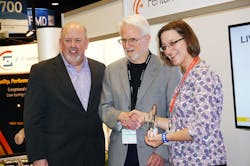Interview: Blake Peterson, Microwaves & RF “Living Legend”
This spring, we began a new awards program—the “Best of Microwaves.” While most of the categories reflected how well companies communicate with engineers and the resources and intellectual property (IP) they make available, we also named our first “Living Legend.” This award was inspired by our online hall of fame, dubbed “Microwave Legends.” It occurred to us that we could give an in-person award of the same caliber to someone who has greatly impacted the microwave industry. Our first “Living Legend” award went to retired Agilent Technologies employee Blake Peterson.
Shortly before his discharge from the US Navy in November 1956, Blake accepted a job offer from Hewlett-Packard Co. (HP). He spent his first year in production, followed by a stint as a technical writer, where he authored the first-ever HP schematic diagrams using transistors in place of vacuum tubes. He soon realized that his specialty was technical support and spent his career churning out application notes, training programs, and teaching courses. Herewith, an interview with Blake, who is as nice a person as one could ever hope to meet:
NF: How long was your career at HP/Agilent?
BP: Almost 45 years. HP/Agilent could not have been a better employer. I received more than one call from head hunters, and I told them that I had absolutely no interest in leaving HP/Agilent.
NF: You created renowned Application Note 150, “Spectrum Analysis Basics.” Did you have any idea that it would make you famous in the microwave industry? Are you surprised that people have used that application note as a reference for so long?
BP: I had no idea what impact the app note would have, and I am indeed surprised that it is still so popular. However, basics—real basics—are needed as building blocks for understanding more advanced technology.
BP: I was managing the technical writers who created the operating and service manuals when this analyzer was introduced. Not only was this analyzer a new product, it was HP’s entry into a new area of test and measurement—an area in which the tech writers had no experience to draw on. So I wrote a good part of the manual and laid out the schematics for it. Producing that manual was indeed a challenge. HP would not ship a product without a manual, so we had to get it done on time.
NF: When personal computers (PCs) came along, you recognized how computer-based tools could help the design process and quickly began working on them. How many did you create in total? Which do you think had the most impact?
BP: When interviewing new EE graduates, I found that most could not explain technical processes in simple terms. For example, most were familiar with how an amplitude-modulation (AM) radio works, but had no idea how a basic spectrum analyzer works. I would ask: What do you get as you continuously tune your radio? Loudness versus frequency. Then how do we convert an AM radio into a basic spectrum analyzer? Replace the speaker with a calibrated screen, get rid of automatic gain control, put in a sweep generator to tune the local oscillator, and replace the antenna with an input connector. Now we have a visual picture of loudness (amplitude) versus frequency and can easily examine a signal’s bandwidth, distortion, etc.
I wrote some 50 animated programs to provide insight into spectrum analysis, network analysis, and various communication schemes. I included a program that shows the relationship between rotating vectors and sine waves. It could be used to show the impact of non-uniform group delay. You can set the phase relationships among the frequency components at the input of a device and see what waveform results. Since non-uniform group delay means different transit times for the various frequency components, their phase relationships are different at the output of the device. By setting the new phase relationships and rerunning the program, you can see the impact of the non-uniform group delay.
Overseas Pioneer
NF: These days, business travel to China is fairly typical from the US. Yet you were part of one of the first groups to be invited to travel to China. Can you tell us about that experience?
BP: China was emerging from its Cultural Revolution and was woefully behind in technology. We were taken to their technology center in Beijing and shown their X-band waveguide reflectometer setup as an indication of their capability. There was no sign of automation! My role was four full-day spectrum-analyzer seminars. I lost my voice, and the attendees could not have been more considerate: They brought soft drinks and offered to postpone. However, I could whisper to the interpreter and he had his full voice.
I had some free time, and my wife and I—all of us were encouraged to bring our wives along, and five of us did—walked the streets around the hotel and the Forbidden City, which was close by. Everywhere we went, people smiled and nodded and were quite friendly. A bike rider said, “Hello, how are you?” as he rode past. While we nine were setting up and doing our lectures, our wives were provided with a van, interpreter, and a tour guide. Their stops included a first- or second-grade class—they sang for the students—and off-limits areas of the Forbidden City. We all got a tour of the Great Wall. All in all, it could not have been a better experience.
Blake Peterson (center) and his colleagues take in the sights during an early China trip.
NF: You created “Blake Peterson University (BPU),” a required training series for all college hires at Agilent. What advice do you find has transcended time and changes in technology? And what basic knowledge do engineers still need to know?
BP: “BPU” was coined by someone else. I certainly was surprised, and honored, by the tag. It is true that for many years, I was involved in training new engineers joining marketing teams or the field sales force in some capacity. I’ll let someone else decide on the merits of my involvement. However, I did feel that the real basics—how to describe it: the ABCs of technology—are needed to form the basis for understanding more advanced technology, and I did my best to provide that basis. And technology certainly has advanced since I retired.
Peterson receives his "Living Legend" award from Editor-In-Chief Nancy Friedrich and Penton VP Market Leader Bill Baumann.
NF: Through all of your years as an educator, mentor, and technical writer, you have met and trained countless people. You devoted a lot of time and energy to your career. Yet you are known for being a family man. What advice do you have for young engineers about life and balancing work and family?
BP: First of all, find a job that you really like so that it does not weigh on you at home. Also, find a job that allows time for family. I had the perfect job at HP/Agilent. I travelled internationally a lot and my wife accompanied me on several of my business trips. I had freedom to come and go as needed when my wife was battling cancer. I certainly hope that there are companies out there with similar philosophies and that people are fortunate enough to find one.
NF: On behalf of the RF/microwave industry, thank you for all that you have done to educate engineers and move this industry forward.
About the Author

Nancy Friedrich
RF Product Marketing Manager for Aerospace Defense, Keysight Technologies
Nancy Friedrich is RF Product Marketing Manager for Aerospace Defense at Keysight Technologies. Nancy Friedrich started a career in engineering media about two decades ago with a stint editing copy and writing news for Electronic Design. A few years later, she began writing full time as technology editor at Wireless Systems Design. In 2005, Nancy was named editor-in-chief of Microwaves & RF, a position she held (along with other positions as group content head) until 2018. Nancy then moved to a position at UBM, where she was editor-in-chief of Design News and content director for tradeshows including DesignCon, ESC, and the Smart Manufacturing shows.



